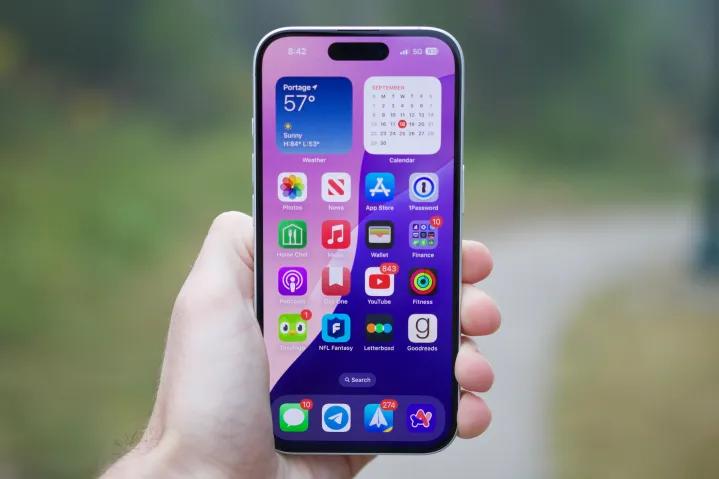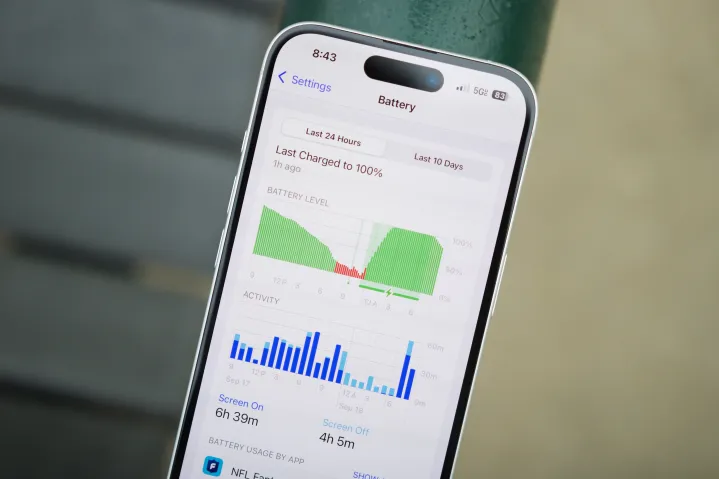This year, Apple went all-out with the iPhone 16. Not only does it come in some of the best-looking colors for phones this year, but it also boasts a two-generation leap in processor with the A18, the Action button, and the new Camera Control button. It’s definitely blurring the lines between the base model and the Pro.
But what if you are currently using an iPhone 14? Is it worth upgrading to the iPhone 16? Let’s break it all down.
iPhone 16 vs. iPhone 14: specs
| iPhone 16 | iPhone 14 | |
| Dimensions | 147.6 x 71.6 x 7.8mm (5.81 x 2.82 x 0.31 inches) | 146.7 x 71.5 x 7.8mm (5.78 x 2.82 x 0.31 inches) |
| Weight | 170 grams (6 ounces) | 172 grams (6.07 ounces) |
| Display | 6.1-inch Super Retina XDR OLED
Dynamic Island 2556 x 1179 resolution at 460 ppi 1000 nits typical brightness 1600 nits HDR brightness 2000 nits peak outdoor brightness 1 nit minimum brightness |
6.1-inch Super Retina XDR OLED
2532 x 1170 resolution at 460 ppi 800 nits typical brightness 1200 nits peak HDR brightness |
| Colors | Ultramarine
Teal Pink Black White |
Blue
Purple Yellow Black Starlight PRODUCT(RED) |
| Processor | A18 | A15 |
| RAM | 8GB | 6GB |
| Software | iOS 18 | iOS 16 |
| Support | Minimum 5 years | Minimum 5 years |
| Apple Intelligence | Yes | No |
| Rear camera | 48-megapixel Fusion, f/1.6
12MP ultrawide, f/2.2 .5x, 1x, 2x optical zoom options |
12MP main, f/1.5
12MP ultrawide, f/2.4 .5x, 1x optical zoom options |
| Front camera | 12MP, f/1.9 | 12MP, f/1.9 |
| Macro photos | Yes | No |
| Spatial photos and video | Yes | No |
| Latest-generation Photographic Styles | Yes | No |
| Action Button | Yes | No |
| Camera Control | Yes | No |
| Battery | 3,561 mAh | 3,279 mAh |
| Charging | USB-C 27W (50% in 30 minutes)
25W MagSafe charging 15W Qi2 wireless charging 4.5W reverse wireless |
Lightning, 27W (50% in 30 minutes)
15W MagSafe charging 15W Qi wireless charging |
| Price | From $799 | From $599 |
| Review | iPhone 16 review | iPhone 14 review |
iPhone 16 vs. iPhone 14: design

The iPhone 14 and iPhone 16 both have the flat edges that Apple has used since the iPhone 12. However, that’s where the similarities basically end. While the iPhone 14 has a diagonal camera layout for the dual camera setup, the iPhone 16 has a new vertical layout that is reminiscent of the iPhone X and iPhone 12. It’s a subtle change, but a welcome one.
The iPhone 14 also still has a silent/ring switch, whereas the iPhone 16 replaces that with the Action button, which debuted on the iPhone 15 Pro last year. Another big hardware design change for the iPhone 16 is the Camera Control button located near the bottom-right edge of the frame.

Apple also replaced the notch, which is still present on the iPhone 14, with the Dynamic Island on the base models starting with the iPhone 15. The notch is static and takes up space to house the TrueDepth front-facing camera and Face ID sensor. However, the Dynamic Island also houses the TrueDepth camera, and it changes size depending on what you are currently doing and is interactive.
The iPhone 16 only comes in five colors, but three of those are absolutely stunning: Ultramarine, Teal, and Pink. There’s also the standard black and white options. The iPhone 14 comes in six colors: blue, purple, yellow, black, Starlight, and Product Red.
iPhone 16 vs. iPhone 14: display

Aside from the switch to the Dynamic Island from the notch, the displays are very similar to each other. They both have a 6.1-inch Super Retina XDR OLED display and a maximum 60Hz refresh rate. However, the iPhone 16 does reach higher levels of brightness at 1,000 nits typical use, 1,600 nits for HDR content, and 2,000 nits peak outdoor brightness, while getting as low as 1 nit of minimum brightness. For the iPhone 14, it is typically around 800 nits and only goes up to 1,200 nits for HDR content.
Both phones also have Ceramic Shield, though the iPhone 16 uses the latest generation, which Apple claims is “tougher than any smartphone glass.”
iPhone 16 vs. iPhone 14: software and performance

When the iPhone 14 originally came out in 2022, it shipped with iOS 16 out of the box. On the inside, it has an A15 Bionic chip and 6GB RAM, and storage options ranging from 128GB to 512GB. Apple guarantees a minimum of five years worth of major iOS updates and security patches, which means the iPhone 14 should last through 2027.
While the iPhone 14 can also get the iOS 18 update, it won’t be able to fully support all the features. That’s because iOS 18 is Apple’s first iOS update that will bring in big AI tools with Apple Intelligence, and the minimum threshold requirement for that is an iPhone 15 Pro with the A17 Pro chip. So again, while the iPhone 14 can get new iOS 18 features like new home screen and Control Center customizations, RCS messaging and Send Lter for Messages, a new Photos app, and more, it won’t be getting any of the Apple Intelligence features.

The iPhone 16, on the other hand, is a base model iPhone that is built from the ground up for Apple Intelligence. It ships with iOS 18 out of the box, though Apple Intelligence won’t actually appear until the iOS 18.1 update. Apple also equipped the iPhone 16 with the A18 chip, which is a three-year jump in performance, and 8GB RAM. With Apple’s commitment to at least five years of support, the iPhone 16 should last through 2029.
To get a sense of how much faster the performance on the iPhone 16 is, take a look at the chips. Apple said that the iPhone 16’s A18 chip is 30% faster in CPU performance over the iPhone 15’s A16, and the GPU is 40% faster. Considering that the iPhone 14 is from two years ago with the A15, the boost in performance is quite significant. The A18 is also much more power efficient, which translates to better battery life.
iPhone 16 vs. iPhone 14: cameras

The iPhone 14 is the last base model iPhone with a 12-megapixel main camera and a 12MP ultrawide lens. Since it doesn’t have a telephoto zoom lens, it only gets up to 1x optical zoom. The selfie camera is also only 12MP, though that doesn’t change with the iPhone 16 either.
For the iPhone 16’s dual camera setup, we have a 48MP main Fusion camera and 12MP ultrawide lens. Despite not having a telephoto zoom lens, the iPhone 16 has a 2x optical zoom through its main lens, and is capable of macro photography, which is absent on the iPhone 14. It’s also able to take spatial photos and video for the Apple Vision Pro.

While the iPhone 14 still has Photographic Styles, Apple improved the feature for the iPhone 16 line with the latest-generation Photographic Styles. There are more styles to choose from, and you can fine-tune the color and tone even more to get the exact kind of style you want. And the best part? You can change the style used on a photo after the fact, which wasn’t possible before.
And since the iPhone 16 will be able to have Apple Intelligence features, it will get the Clean Up tool in Photos. With Clean Up, you’ll be able to remove unwanted objects or people in the background of your photos, similar to Google’s Magic Eraser.
iPhone 16 vs. iPhone 14: battery and charging

Apple only recently switched over to USB-C on the iPhone, starting with the iPhone 15 line. So the iPhone 14 still uses the proprietary Lightning connector, while the iPhone 16 uses USB-C.
Inside the iPhone 14 is a 3,279mAh battery, while the iPhone 16 has a 3,561mAH battery. When you combine the power efficiency of the A18 chip over the A15, the iPhone 16 will definitely last longer than the iPhone 14.
However, though the iPhone 16 uses USB-C, Apple didn’t actually improve the wired charging speed. Both the iPhone 14 and iPhone 16 still charge at 27 watts wired, which means about 50% charge in 30 minutes.
The iPhone 14 caps out at 15W for MagSafe and wireless charging speeds and does not have reverse wireless charging. On the other hand, the iPhone 16 can get up to 25W MagSafe charging, 15W Qi2-wireless charging, and 4.5W reverse wireless charging.
iPhone 16 vs. iPhone 14: verdict

As of right now, Apple still sells the iPhone 14 and iPhone 15, along with the iPhone SE and the rest of the iPhone 16 lineup. If you are looking to buy a brand new iPhone, then honestly, the iPhone 16 is the way to go. It has received a lot of the previous Pro-exclusive features (Dynamic Island and Action button) and comes in some amazing colors.
Those who are still using an iPhone 14, well, you should probably upgrade if you can afford it. The iPhone 14 is already two years old at this point, and while a lot of people may not upgrade every year, between two or three years is more appropriate.
Especially consider all of the features. The iPhone 14 can technically get iOS 18, but you’ll be missing half the features since it can’t run Apple Intelligence. Apple also massively improved the main camera on the iPhone 16, and the new Photographic Styles is definitely a fun addition for photographers.
The Action button and Camera Control are also very nice hardware changes that are quite useful. In fact, with the iPhone 16, there’s actually less reason to even consider the Pro models — that’s how good the base model is this year.